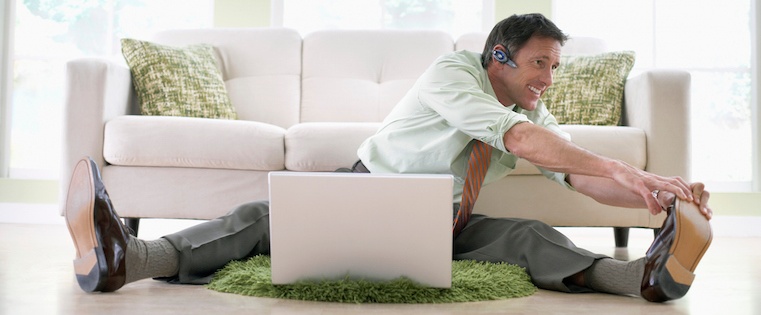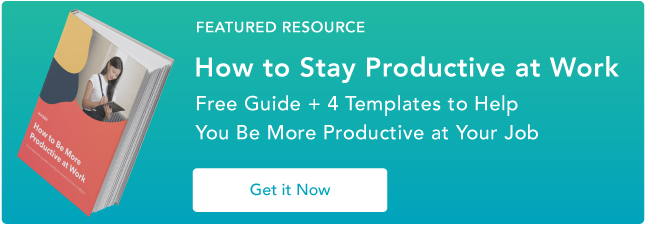
Although we hear about the health benefits of regular exercise all the time, hectic schedules can make it seem impossible to fit workouts in. The prospect of packing a gym bag, trudging to your local gym, working out, showering, changing, and trudging back to where you came from takes an awful lot of time.
But you aren't doing yourself any favors by disregarding your health. When you neglect exercise, you're putting both your physical and your mental health at risk, which can negatively impact your productivity and effectiveness at work.
One great solution? Work physical activity into your everyday routine. In fact, researchers found that people who exercise during the workday are actually more productive at work, even though they technically logged fewer hours.
An office workout can vary widely in type and intensity -- from swapping your desk chair out for a stability ball to going for a run during your lunch break. Here are a few ideas to get you started.
10 Little Ways to Sneak in Exercise at Work
1) Turn your commute into a workout.
The time you spend commuting is already time you're logging each and every day. So why not turn that time into a workout?
There are ways to incorporate exercise into every type and length of commute. If you live fairly closeby, try speed walking, jogging, or cycling to work instead of driving or taking public transportation. Be sure to check for the best and safest routes in your location.
If that distance is too daunting, try parking some distance away from work or getting off the bus or subway a few stops earlier than normal to walk or jog the rest of the way.
Doing exercise during your commute instead of just sitting there will make you feel good while helping you keep fit, even in winter. You just have to dress properly for it.
2) Work out during lunch.
In a recent post on how effective managers organize their time, HubSpot Marketing Director for Asia Pacific and Japan Ryan Bonnici let me in on his daily lunchtime routine: Every day, he blocks off 12:00–1:00 P.M. for a run, a swim, or catching up with a friend. Not only does this benefit him physically, but he says it's also necessary for productivity and happiness.
If you can't work out before or after work, lunchtime is your next best bet for fitting in a real workout into your busy schedule. If your office has a gym, you have a lot of workout options. If not, you might opt to go for a half-hour run or a speed walk around your neighborhood or in a nearby mall. It'll take a little planning ahead -- like packing a gym bag -- but it can easily be done. Just don't skip lunch altogether, as your body does need to be refueled.
3) Replace your desk chair with a stability ball.
Ever seen someone in an office environment sitting on what looks like an exercise ball in lieu of a chair? It's not for comfort or looking cool -- there are actually a lot of health benefits that come with sitting on stability balls at work.
For one, it helps you practice better posture by forcing proper spine alignment. Why? Because your body is constantly trying to balance itself on the ball, and a seated position with proper spine alignment is the easiest to balance with.
Sitting on a stability ball also strengthens your abdominal muscles because those are the muscles your body uses to compensate for changes in balance. Basically, you're getting a low-intensity abdominal workout every time you sit down -- and those hours add up.
Finally, one study found that children's attention increases when they sit on stability balls. While no studies have been done on how stability balls affect adults' attention, it's possible we'd feel the same effects.
4) Take short "active breaks" during the workday.
On really busy days, you can still work out in short breaks by getting up, stretching your legs, and walking around. It's all about making movement a natural part of your day.
Taking short breaks to be active, even if you're just walking, will help you shed extra calories and help you concentrate during the time when you are working. Mental concentration is like a muscle, according to John P. Trougakos, an assistant management professor at the University of Toronto Scarborough and the Rotman School of Management. After sustained use, it needs a rest -- just like someone lifting weights at the gym needs rest before doing a second round of repetitions.
When you reach a breaking point, make a point of moving around -- like a 10-minute walk around your building, or up and down the stairs -- instead of sitting at your desk checking email. This can have both long- and short-term positive effects on your mood: One study published in the Scandinavian Journal of Medicine and Science in Sports found that people who take walking breaks during work feel more enthusiastic, less tense, and generally more relaxed and able to cope than when they don't take walk breaks.
5) Pace while you're on the phone.
Chances are, you spend most of your day sitting down. Unless you need to be on your computer at the same time, you might as well take advantage of the opportunity to stand up and move around while you're on a call. Every extra step counts, and it'll be a welcome break for your back and your muscles.
Remember: Physical activity doesn't have to be formal exercise to have its benefits: Even simple, unconscious fidgeting is good for your muscles and can burn some calories. Plus, you may find that the movement helps keep you focused and alert.
6) Speed walk your errands.
In the spirit of turning activities you're going to do anyway into little exercise routines, try speed walking your errands. This is an easy way to make movement a natural part of your day, and it means having a lot of errands to run won't cause you to miss a workout.
And, while you're at it, don't use a shopping cart. Human beings are designed to lift and carry things. Remember: Beneficial exercise happens in more places than the gym.
7) Go the long way.
Here's another way to add movement to your day: Take the long way when you have a few moments to spare. This might mean taking the stairs instead of the elevator, parking farther away from your office, or going to the bathroom that's across the building instead of right by your desk. After all, studies show that regular, low-intensity exercise such as walking can help boost energy levels -- especially in people who suffer from fatigue, as counterintuitive as that sounds. Plus, think about how all of those extra steps add up after months and even years.
8) Start or join a sports or fitness club at work.
When it comes to workouts, sometimes one really is the loneliest number. But chances are you aren't the only one at your office trying to fit exercise into a busy workday. Why not seek out others who want to work out with you and start some sort of sports or fitness club?
It could be as simple as a push-up club that meets before lunch three days a week, or a running club that does an after-work run. Or, you could take it a step further and rally your coworkers to join a local intramural league. For adult amateur leagues, try typing something like "adult basketball leagues [your city here]" into Google. (Read this blog post for more Google search tips.)
If you're not sure what your coworkers are into, try creating a survey using SurveyMonkey or Google Forms and emailing it to them to gauge interest. Ask them whether they'd join some sort of fitness club, what sports or fitness activities they're interested in, and when they're most likely to be available.
9) Stretch at regular intervals.
The prospect of stretching at your work desk might seem really awkward, but we're not suggesting you do squats at your desk, here. There are plenty of stretches you can do either sitting down or standing up that can help ward off pain and stiffness while boosting your energy and alertness.
Work some stretches in at regular intervals throughout the day -- even if they're just for a minute. The folks at WebMD suggest torso twists, leg extensions, standing up and sitting down several times without using your hands, shrugging your shoulders to release tension in your neck and shoulders, and circling your wrists and hands in air circles.
10) Do (subtle) workouts at your desk.
I know, I know. If you thought stretching at your desk was awkward, what do desk workouts look like? But researchers have found that even one-minute spurts of activity throughout the day can be beneficial. Here are some ideas for subtle workouts at your desk from Fitness Magazine:
- Flex or tighten your abs and hold for 30 seconds. Release, and repeat 10 times.
- Squeeze your glutes and hold for 30 seconds. Release, and repeat 10 times.
- Buy a hand gripper and use it at your desk to work out your forearms and hands. (Here are some exercises you can do with a hand gripper.)
- If you're at a standing desk, do calf raises for one full minute.
How do you sneak in exercise at work? Share with us in the comments.
from HubSpot Marketing Blog http://blog.hubspot.com/marketing/exercise-at-work
Via http://blog.hubspot.com/marketing/exercise-at-work

No comments:
Post a Comment